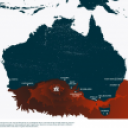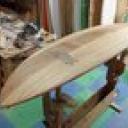Board Test: Polyurethane vs. Varial Foam technology


I wonder why the new foam costs 30% more? Is it to cover initial R&D costs? Are the chemicals used more costly than what is used in traditional PU blanks? Is it the 'green tax'? Speaking of which, the article mentions the same old toxic cocktail of chemicals in the first paragraph but fails to address it in the rest of the article.
Still, an interesting article and like most products, they just have to get a few high profile surfers on board (no pun intended) and the rest will follow.


Why would anyone pay 30% more for a board made from the same toxic materials that surfs like a PU and the deck still dents? Sounds cuckoo clock crazy to me.
Disagree strongly about innovation not happening in Oz. It might not be getting airplay in the media but I've seen some extraordinary board building innovation happening around here.
Fuck we had full vac bagged epoxy glassed bamboo boards being made commercially here 15 years ago. Stronger, lighter, more environmentally friendly.
The market keeps choosing pu/pe.


Agree with freeride
"Disagree strongly about innovation not happening in Oz. It might not be getting airplay in the media but I've seen some extraordinary board building innovation happening around here."
We are in final testing with a hybrid resin that we launch in a few weeks, hopefully Stunet or someone here can put it in the "Design Outline" news so its not always us looking to the US for innovation.
Yes the market keeps choosing PU/PE as most of the factories are set up that way to make $$, the aim
is to innovate without changing their work structure too much at one time, slowly adapt over time


Also according to my shaper really hard to get reliable supplies of exotic or new materials. I doubt these blanks are available here yet and if they are probably rare as hens teeth. As with everything, it is cheaper and far more readily available when you have a population of 300mil+. To get something different and cheap out there here is no easy task. The ramp up costs would be huge I would think and people who are making blanks need to ditch their investment and do something else. Big ask or am I completely wrong.


You want innovation, just look at Josh Dowling in Victoria.


Love that 6'4"step bottom stinger on his facebook


i bought a bamboo board back in the day- it was great.




stunet wrote:
sanded wrote:...hopefully Stunet or someone here can put it in the "Design Outline"
If you've got an info pack feel free to send it to me at stuart@swellnet.com.au
Stu I know its a bit late - but sent you the info/TDS on the Surfset Resins yesterday, have a look at the email "Epoxy hybrid" and let me know if you want anymore info.
Cheers


The marketing spiel for varial foam , takes a lot of words to declare that "lighter is better , and has more flex"....we already knew that...which is why compsand builders use various densities of EPS...and glass the boards with fabrics and materials that are fare stronger and lighter than standard fibreglass cloth.....Ive used EPS since before the demise of Clarks(US) , and a few years back , I added SUrfBlanks Pink to my range of cores. I doubt that varial foam could equal the Pinks for over all performance on composite boards....it's a simple matter of producing strong , lightweight PU blanks.... it's logic , and SurfBlanks Pink foam is quite a few years ahead of the pack.


Blank stiffness can't significantly affect flex directly.


Any stiffness in the build process from core to finish coat will always affect flex.


blindboy wrote:Future materials?
http://engineering.nyu.edu/press-release/2015/05/12/metal-composite-will...
Interesting research blindboy.....sounds like it would be difficult to shape , but may have possibilities for some composite constructions.......will probably be too expensive , and so , not viable for many commercial applications where end price is a consideration...... like surfboards.


foreday rider wrote:Any stiffness in the build process from core to finish coat will always affect flex.
Not necessarily significantly.
It's like filling the voids in a truss with foam.


Roy Stuart wrote:It's like filling the voids in a truss with foam.
......foam ? ...better to fill them with flubber , or synthetic splodge.


The point is that stiffness is determined by the outer skins and how far apart they are, the blank has little effect, apart from influencing how substantial the skins are.


Roy Stuart wrote:The point is that stiffness is determined by the outer skins and how far apart they are, the blank has little effect, apart from influencing how substantial the skins are.
....unless you build the core with solid aluminun, and skinned it with foam ?......if you build the deck skin in Currumbin , and the bottom skin in Port Macquarie , that would have significant effect....depends on how far outside the box you're prepared to think.


Ridiculous examples aside ( i.e. we can assume that we are talking about skins which are denser and stiffer than the core. Your example of a board cored with solid aluminium will result in a board with negative buoyancy) then my point stands.
Slight differences in skin stiffness will have an effect, but that's a different question altogether.


...so that's why when a board snaps and delaminates the fibreglass and resin are so stiff and flexible. Or Roy could just be talking total crap.


blindboy wrote:...so that's why when a board snaps and delaminates the fibreglass and resin are so stiff and flexible. Or Roy could just be talking total crap.
It's not clear what you are attempting to say there.


Roy Stuart wrote:The point is that stiffness is determined by the outer skins and how far apart they are, the blank has little effect, apart from influencing how substantial the skins are.
No that's not correct...it's too narrow an assumption .....for instance the difference in stiffness between off-the-shelf poly blank and light EPS in a 6lb board.....or a solid balsa board sealed with marine varnish to prevent water intrusion....or a chambered wooden board , as opposed to a solid wooden board.....or a thousand different possible variations of the above....the outer skin has significance , and so does the core.....disregarding either will always have significant consequences in performance.


foreday rider wrote:Roy Stuart wrote:The point is that stiffness is determined by the outer skins and how far apart they are, the blank has little effect, apart from influencing how substantial the skins are.
No that's not correct...it's too narrow an assumption .....for instance the difference in stiffness between off-the-shelf poly blank and light EPS in a 6lb board.....or a solid balsa board sealed with marine varnish to prevent water intrusion....or a chambered wooden board , as opposed to a solid wooden board.....or a thousand different possible variations of the above....the outer skin has significance , and so does the core.....disregarding either will always have significant consequences in performance.
It is correct, actually .
Unless the blank is stiffer than or as stiff as the outer skins ( which it almost never is) then the stiffness of the board is almost completely determined by the skins.
Regarding what was being discussed i.e. the effect which blank stifness has upon finished upon board stiffness, a stiffer blank will not make a stiffer board.
In fact, the reverse can be the case since a denser blank can allow lighter glassing, and lighter glassing reduces the stifness of the finished board.
.


Fibreglass and resin have no intrinsic flexibility. They flop around. Building them into a shell shaped like a surfboard may add some flexibility but that is an unproven assumption. Therefore to assert that the flexibility in a surfboard comes exclusively from its shell demonstrates an appalling lack of understanding of the materials used to build most surfboards......but then you just make over sized wooden logs that have no point of comparison to what 99.99% of surfers actually ride.


blindboy wrote:Fibreglass and resin have no intrinsic flexibility.
They flop around.
Flopping around indicates the reverse... i.e. considerable flexibility.
e wrote:but that is an unproven assumption. Therefore to assert that the flexibility in a surfboard comes exclusively from its shell demonstrates an appalling lack of understanding of the materials used to build most surfboards......
I said the opposite.. that the stiffness of the board comes mostly from the outer skins, ( provided that the skins are stiffer than the core, which they almost always are).
e wrote:but then you just make over sized wooden logs that have no point of comparison to what 99.99% of surfers actually ride.
Physics Mac, play the ball not the man there's a good fellow.
Perhaps a Monday might be a better time to catch you in a lucid moment?


Ha ha to be of any significant value in a surfboard the flex has to return some of the energy used to distort it.......and d'oh stiffness is a measure of flexibility. Play the man? Well you are probably male but a man? Nah. A self-obsessed child by what you have posted previously, too frightened to even state his real beliefs.


Roy Stuart wrote:It is correct, actually .
Unless the blank is stiffer than or as stiff as the outer skins ( which it almost never is) then the stiffness of the board is almost completely determined by the skins.
.
Using words like "unless" and "ALMOST completely" suggest that your sitting on the fence a bit......(lol).....a surfboard is the sum of all it's parts , and all parts interact substantially......the core has great influence on the buoyancy , which in turn has great influence on the volume , which has great influence on the profile thickness , which has great influence on the stiffness. The core can be stringerless , have a centre stringer , have multiple stringers , have perimeter stringers or have multiple perimeter stringers. The core can also be a combination of different foam densities to produce a specific overall , or engineered stiffness or flexibilty ........."almost completely" won't cut it these day's Roy......most surfers are quite sure of what they want in performance , regardless of the amount of hype out there these days.


foreday rider wrote:Roy Stuart wrote:It is correct, actually .
Unless the blank is stiffer than or as stiff as the outer skins ( which it almost never is) then the stiffness of the board is almost completely determined by the skins.
.
Using words like "unless" and "ALMOST completely" suggest that your sitting on the fence a bit......(lol)....
No I'm just using language precisely, so that what I write is as close to being exactly what I mean as possible. That is necessary when it comes to matters of physics.


The correct answer would be "yes" Roy. That's not that complex.


Roy Stuart wrote:No I'm just using language precisely, so that what I write is as close to being exactly what I mean as possible. That is necessary when it comes to matters of physics.
..the core has a direct and unmistakable effect on stiffness.......regardless of any linguistic disclaimers you throw up as an out-clause ......your use of language in this case seems to be intentionally un-precise.


kayu wrote:Roy Stuart wrote:No I'm just using language precisely, so that what I write is as close to being exactly what I mean as possible. That is necessary when it comes to matters of physics.
..the core has a direct and unmistakable effect on stiffness.......regardless of any linguistic disclaimers you throw up as an out-clause ......your use of language in this case seems to be intentionally un-precise.
No, I am being precise.
When the skins are far stiffer than the core as is the case in the type of construction which was being discussed, the core has only an insignificant effect on the stiffness of the board.
It's simple mechanical engineering.
.


Roy Stuart wrote:No, I am being precise.
It's simple mechanical engineering.
.
....you're being quite vague actually......the core is never insignificant.....good mechanical engineering requires attention to all details ...... what type of core would you use , and why ?


stunet wrote:....... there appears a real sense of innovation that isn't apparent here in Oz.
There's an old saying Stu , that explains the difference between the US and Australian consumer markets = "In the US , you can market a half developed product , get massive sales , and become rich very quickly.....whereas in Australia , you can spend many years perfecting a new product , and still never make a profit ".........make no mistake , the Aussie underground is still going strong....we just don't blow the trumpet as loud as some.


foreday rider wrote:Roy Stuart wrote:No, I am being precise.
It's simple mechanical engineering.
.....you're being quite vague actually......the core is never insignificant.....good mechanical engineering requires attention to all details ...... what type of core would you use , and why ?
No I'm being precise, you are being vague by misquoting what I have written. specifically, what you've been doing is widening the meaning and scope of my statements. That's what you have done in the comment quoted above. I'm not saying that you are doing that on purpose, but it's happening.
So, I didn't say that the core is insignificant, I just said that core's effect on stiffness is not significant where the core is less stiff than the skins ( as is always the case with the kind of construction which was being discussed).
So, a stiffer blank won't have a significant effect on finished board stiffness..


Roy Stuart wrote:So, a stiffer blank won't have a significant effect on finished board thickness.
Thickness ?....thickness will be determined by the core's buoyancy.......the often quoted "volume" will give different flotation if the core density is changed...as in EPS core instead of poly blank...The Varial foam being discussed claims to have more "spring" in the flex , so the Varial foam must be stiffer than the other cores in the test boards.....the stiffness of the core will determine the way it's glassed , to give a specific weight and some durabilty to the finished board.....it's quite doable to engineer a light EPS core with a specific stringer arrangement that greatly increases longitudinal elasticity.....and in this case , the core totally dominates and determines the way it needs to be glassed.


I had intended to say 'stiffness' not thickness, so have edited my comment accordingly.
Nevertheless, blank density or 'buoyancy' need not affect finished board thickness, that much should be obvious.
It is true, however, that an increase in blank density can allow lighter glassing, in which case the denser blank can lead to a less stiff board even if the blank is stiffer. It doesn't have to though.


Which is more pertinent to your enjoyment of the ride Roy - Stiffness or thickness ?


Stiffness or thickness?
That's an odd question since thickness gives more stiffness, all else being equal.
I tend to prefer boards which are thin, flexible, heavy, long, and wide.


Sorry mate, didn't realise you were talking about surfboards.
Boom Tish.


Roy Stuart wrote:Nevertheless, blank density or 'buoyancy' need not affect finished board thickness, that much should be obvious.
If you build it 6" thick , they won't send you to prison , no ......but it would be bad design . Too much buoyancy is always bad design.......and a required buoyancy should determine thickness in any given design.


foreday rider wrote:Roy Stuart wrote:Nevertheless, blank density or 'buoyancy' need not affect finished board thickness, that much should be obvious.
Too much buoyancy is always bad design.......and a required buoyancy should determine thickness in any given design
.
'Too much' of anything is bad design by definition, but you miss the point, again.
You said:
e wrote:.Foreday rider: thickness will be determined by the core's buoyancy.......the often quoted "volume" will give different flotation if the core density is changed...as in EPS core instead of poly blank.
... clearly that's not necessarily the case, since core density does not determine finished board density.
Furthermore neither core density nor core stiffness determine finished board flexibility.


Roy,so does that mean triple stringer bds have the same flex as stringerless ?


Because the stringer density is similar to that of the outer laminate it will stiffen and strengthen the board. When the core is much less dense than the skin, that doesn't happen to a significant extent.


So stiffness increases with density? Not in the real world! They are two separate characteristics of a material. Not to mention that the materials in question are arranged perpendicular to each other so comparing their relative stiffness is absurd.


The point is that the stringer material is similar in stiffness to the outer skins, therefore it will make the finished board stiffer.
When the core material is far less stiff than the skins then it will not contribute significantly to the stiffness of the finished board.
You are correct, I should have referred to stiffness rather than density, that was sloppy of me but because everyone has been referring to blank density as an indicator of stiffness ( which it usually is) I thought it would be simpler to describe it that way. Well spotted anyway.
You are incorrect when you say that " the materials in question are arranged perpendicular to each other so comparing their relative stiffness is absurd" since the fibres in the wooden stringer run fore and aft, as do the relevant glass strands in the skin. Cloth with strands on the bias also have a fore and aft component.
The bottom line there is that the wooden stringer is able to stiffen the board, but foam, which is much less stiff than the skins, doesn't do so significantly.That point hasn't been grasped by quite a few people yet. they keep assuming that stiffer foam will make a stiffer board, which isn't the case in fact it's quite likely that stiffer foam will make a board which is more flexible, as it all depends upon what is in the skins.


.......except that if you rip the skin off it has almost zero rigidity.


Yes that's right, because the skin contribution to the rigidity of the finished board comes from the fact that the skins are spaced apart via the thickness of the board. It's basic beam theory, the further apart the skins are the stiffer the overall structure, all else being equal. The foam in the middle contributes to the stiffness mainly because it is acting as a spacer. The foam also helps to prevent the skin which is under compression from buckling when the board is bent. That's more to do with resistance to snapping than flexibility though.


So you are suggesting that a hollow board would have the same properties of flex and rigidity as one of the same proportions with a foam core? If so, show us your data.


Another comparative material test by Surfer's Village. This time standard PU foam vs. Varial foam:
Identical computer shaped boards road tested
Surfersvillage Global Surf News, 10 May, 2015 - We’ve been using the same surfboard materials for almost 60 years. Why? Polyurethane foam and fiberglass is cheap, abundant (unless you count the 2005 Clark Foam crisis) and most of all, familiar. Every other aspect of surfing has made technological leaps and bounds: fins, leashes, boardshorts and wetsuits but surfboard materials remain the same. It’s a sad, familiar, toxic, story. But a new company on the market is offering an alternative to PU blanks, Varial Foam
Varial was developed in the aerospace industry and has a tighter cell structure than standard polyurethane foam. According to the makers, the blanks are 25% lighter and are substantially stronger.
Varial Foam doesn’t use a stringer. Instead the foam is engineered to hold a similar flex pattern to that of a PU blank with a stringer. “Varial has 7X the modulus of PU or EPS foam,” says Parker Borneman of Varial. “Modulus is a technical term for the foam’s rigidity. The enhanced rigidity of Varial Foam compensates for the lack of a wood stringer.”
Matt Biolos of …Lost Surfboards, and shaper of our test board, a SubDriver, agrees the cell density in Varial is unique. “It’s easily the tightest cell structure of any foam developed for surfboards,” he says. “It also glasses up very light and flexy.”
The advantage of going stringerless is that it eliminates the inconsistent flex properties of wood - due to the knots and grain density in wood that vary slightly from stringer to stringer. The end result is flex consistency from blank to blank.
Varial is gaining traction in the market and a few shapers out there are backing the foam, most notably Jeff ‘Doc’ Lausch of Surf Prescriptions and Biolos. Then there are a few pros as well who endorse the technology, like Shane Dorian and Ian Battrick.
“Ive ridden it (Varial) everywhere,” says Battrick. “You will notice the second you stand up on Varial it’s so much faster! It feels more lively, responsive, paddles better, and has a nice float.”
So now that we’ve done our tech homework, talked to the makers and to surfers more skilled than us, let’s get going and share what we, the average-to-sometimes-above average surfer, discovered…
We Rode Two Identical Boards:
Both boards were both shaped off the exact same computer file by Matt Biolos and …Lost. They are a SubDriver “Grovel” at 5’11” x 20.25 x 2.5 at 32 Cubic Liters in Polyurethane construction and in Varial/Hydroflex/Epoxy construction.
The Varial board was glassed with epoxy Hydroflex tech. Hydroflex uses a method where resin is injected into the foam blank for strength - reports are that the bonding between the foam and lamination is 600% stronger than with traditional glass jobs. (We can’t prove that but it sounds great!) The tail patch on the Varial/Hydroflex board is an aerospace grade fabric. The PU board is two years old and starting to yellow (except where it’s covered in Posca paint-pen children's artwork.)
First Impressions:
Varial is much lighter. With pad and fins it weighs 6 pounds 7 ounces while the PU counterpart weighs in at 7 pounds 10 ounces.
Float:
Varial has a nice float to it without feeling too ‘corky.’ More buoyancy? Tough call, but if we had to decide, we’d say the Varial is a touch floatier. To gauge if this was all in our heads, we asked Biolos about the difference in float and materials: “Whatever is more light of two exact objects will be more buoyant,” he says. “So, in general, boards built with lighter cores like EPS, XPS or Varial, tend to feel floatier.” Thank you Matt.
Varial convert Ian Battrick said he goes a shave thinner in his dims when ordering a Varial board compared to a PU board.
Polyurethane foam left and Varial foam right at 70x magnification
What We Discovered:
In a variety of conditions the Varial felt like a very lively PU board. It felt a touch springier than the PU, meaning it felt like it snapped back quicker than the PU board. Biolos says the Varial foam can feel more flexible than PU, but in testing I didn’t find this to be a negative. In fact I would say the Varial has a positive, lively ‘zip’ to it.
The Varial board also had that quickness to it that lighter-glassed PU and epoxy boards tend to have. Best though was that the board didn’t chatter or bounce in chop like a lot of epoxy or EPS boards will do. It had the same positive drive familiarity as PU constructions.
Varial claims that the blank will retain this zippiness for the lifespan of the board, and the board will also never yellow as the foam is resistant to UV rays.
Of note on durability, the board is strong. We stood on it. It flexed. We ran over someone’s board in the lineup (Not our fault - the surfer ditched his Channel Islands) with no ill effects on the Varial. The Varial deck did have some pressure denting - less than you’d find on a PU but more than on an epoxy or Firewire constructed surfboard.
Construction diagram of our test board
The Takeaway
It surfs like a light, team-glassed PU board (even a bit more lively) but with excellent durability characteristics. The Varial is strong without many of the drawbacks of lighter, non-PU constructions: stiffness, chattering in chop and being extra floaty. The downside is it costs more (30% says Varial). Some surfers might not want a board that feels ’team light’.
The test board rode like a PU, which made me like it, which led me back to asking Biolos why collectively we as surfers are so picky and obsessed with finding NEW constructions that mimic - as exactly as possible - the same OLD polyurethane we’ve been using for so many decades. Why use PU as the benchmark that all other constructions are measured?
“Familiarity,” he says. “We were all raised on traditional boards. I think as we move further and further from generations that were exclusively raised on traditional construction, you will slowly see more and more surfers feel comfortable with alternative constructions.”
Biolos added that most of these alternative constructions were developed to aid in small surf but that most of the world class surfing is done in solid surf and the athletes are riding traditional constructions 95% of the time. So why aren’t we embracing a materials revolution?
“Thats what the public sees, and as the public sees, the public does,” says Biolos.”